Upon first blush in Lightning Ridge, you may find an opal-mining town with very little to keep you here for more than a day or so. It reeks of an environment trying a touch too hard to be attractive to tourists. The one and only road to leading into and out of town is lined on each side with billboard after billboard featuring opal-related attractions and opal stores. You see a lot of the same adverts over and over again too - on not only billboards, but lining fences, and even painted and plastered into the general surroundings. It’s a little over the top.
But somehow it also adds to the character of 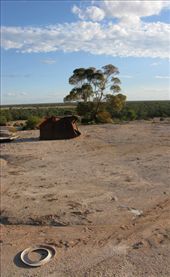 Lightning Ridge, which is quirky and whimsical. There is so very much more than meets the eye if you want to discover its colourful underbelly. Allow yourself to stay a while. Head to the bowling club or one of the handful of cafés to meet some locals, and stay long enough to get to know them. If you do, you’ll see a whole different side to Lightning Ridge that is fascinating.
Lightning Ridge, which is quirky and whimsical. There is so very much more than meets the eye if you want to discover its colourful underbelly. Allow yourself to stay a while. Head to the bowling club or one of the handful of cafés to meet some locals, and stay long enough to get to know them. If you do, you’ll see a whole different side to Lightning Ridge that is fascinating.
Never have we met such a concentrated group of incredibly generous people, who are so proud of their home town. They were willing to give of themselves to help us, and expressed as much interest in our story as we had in theirs.
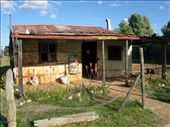 Everybody has a different and unique story of how they came to Lightning Ridge. Only a few people we spoke to were born and raised here; almost everybody comes from somewhere else.
Everybody has a different and unique story of how they came to Lightning Ridge. Only a few people we spoke to were born and raised here; almost everybody comes from somewhere else.
"In the old days of mining here, people came here to disappear. You rarely knew anybody’s name, and those names you knew were probably fake nicknames in any case. You didn’t ask much about somebody, and they didn’t tell too much either," said one person about the opal rush that started in the early 1900s and converted Lightning Ridge from a deserted piece of land to a bustling mining town.
People came from all over the world and bought (or squatted on) "claims": access to small pieces of land with permission to dig shafts to mine for opal. Anybody could and still can do it; for a few thousand dollars you could set yourself up with a claim, a trailer to live in, and much of the equipment you need to operate your small and practically instantaneous mining business.
And although there are still a number of mines and miners in Lightning Ridge, many of the big miners and prospectors are starting to do their active work further a field. It was when this started happening that the town collectively and individually had a choice to make: pack up and move shop, capitalize on the already steady stream of visitors to town wanting to see what "opal fever" is all about. And so it was that tourism became the main draw (and a large income source) for Lightning Ridge. 
What you actually see when you get to Lightning Ridge is a place where history meets the present, and outback meets inland beautifully. The landscape when you drive through old claims sites to a lookout at the site of one of the original opal mine shafts (one of four guided drives for tourists marked by old car doors I might add) is both crowded and expansive. In the foreground you see white piles a few feet high of 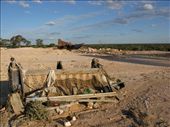 sandstone (pay dirt) everywhere. Rusted out equipment, trailers, rubbish, and even abandoned furniture dot this surreal landscape of rock piles. Dali would have a field day out here.
sandstone (pay dirt) everywhere. Rusted out equipment, trailers, rubbish, and even abandoned furniture dot this surreal landscape of rock piles. Dali would have a field day out here.
Some of the worse-for-wear trailers are still home to prospectors; many are simply abandoned, as the occupants moved to other claim sites after exhausting the possibilities there.
Stunted trees accent the foreground too, and as you look out towards the horizon, the little groupings of greenery start to meld together over an extremely flat expanse of land. It is here in our journey into the outback that we are starting to gain a sense of how vast the outback will be.
The attractions also do great justice to the past and present. Black Queen, for example, is a brilliant piece of "outback theatre with a twist" set in a cottage built by hand by an elderly woman who consistently beat the odds in life. Woven into her story is the story of Gail, the woman who currently owns Black Queen and gives the performances. Stay posted for a future article elaborating on this amazing show.
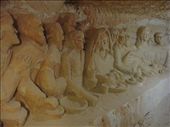 Another attraction beautifully melding past and present is the Chambers Of The Black Hand (notice a "black" - as in black opal - theme?); it is an old mine which didn’t return a huge amount of opal for the miner over the years. So when he tired of picking away in the ground for opal, he combined his
Another attraction beautifully melding past and present is the Chambers Of The Black Hand (notice a "black" - as in black opal - theme?); it is an old mine which didn’t return a huge amount of opal for the miner over the years. So when he tired of picking away in the ground for opal, he combined his 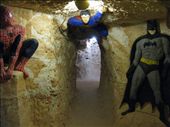 love of working with the soft stone and his love of art and sculpture, and created an exhibit of carvings in the mine more than 11 meters underground that is entirely unique to the world. He refreshed and made new this old mine by creating an
love of working with the soft stone and his love of art and sculpture, and created an exhibit of carvings in the mine more than 11 meters underground that is entirely unique to the world. He refreshed and made new this old mine by creating an 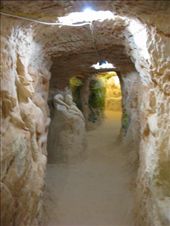 underground world that continues to evolve even now, as evidenced by the many work-in-progress carvings.
underground world that continues to evolve even now, as evidenced by the many work-in-progress carvings.
So it is here, in this setting combing the old with the new, the artistic flare with the gruff mining, and the outback with inland, that Lightning Ridge captivated us for days and wouldn’t let us go. Following are some posts that characterize this place and illustrate our passion for all that is Lightning Ridge.